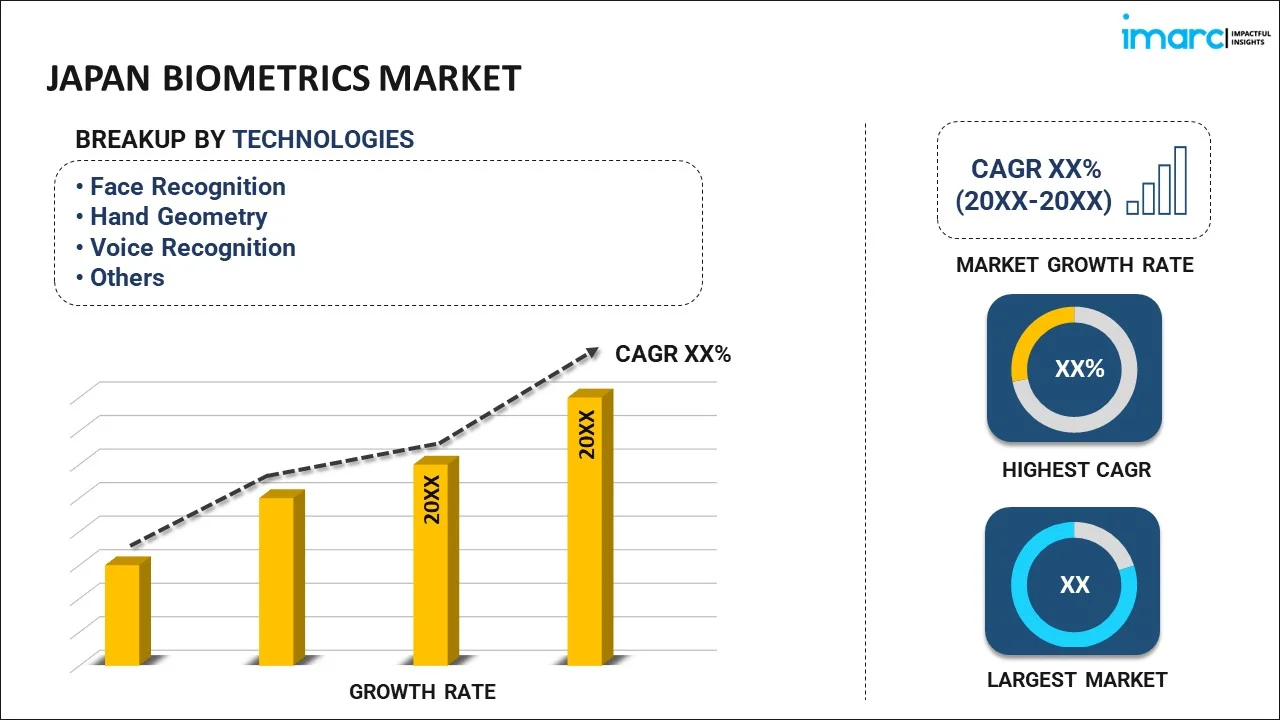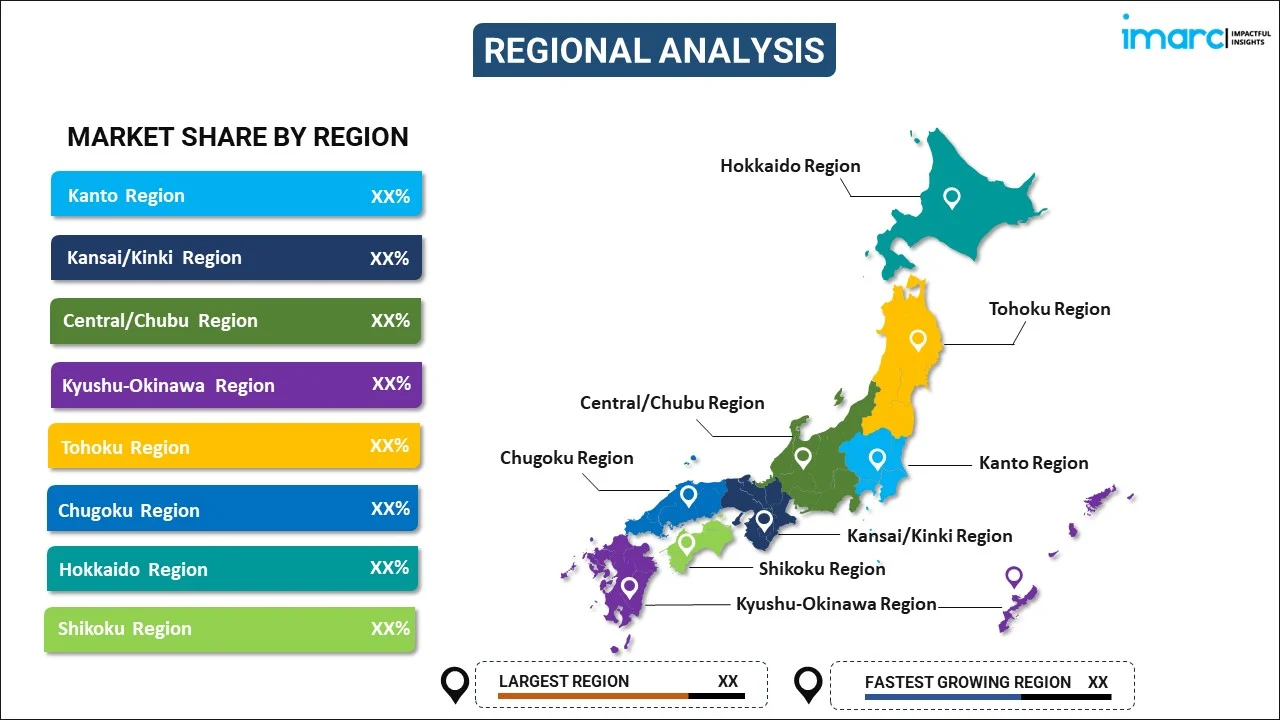
Japan Biometrics Market Report by Technology (Face Recognition, Hand Geometry, Voice Recognition, Signature Recognition, Iris Recognition, AFIS, Non-AFIS, and Others), Functionality (Contact, Non-contact, Combined), Component (Hardware, Software), Authentication (Single-Factor Authentication, Multifactor Authentication), End User (Government, Defense Services, Banking and Finance, Consumer Electronics, Healthcare, Commercial Safety and Security, Transport/Visa/Logistics, and Others), and Region 2025-2033
Market Overview:
Japan biometrics market size is projected to exhibit a growth rate (CAGR) of 12.4% during 2025-2033. The growing concerns about security and identity verification in both public and private sectors, rising adoption in transportation sector for airport security and immigration, and increasing affordability and accessibility of sophisticated hardware and software represent some of the key factors driving the market.
|
Report Attribute
|
Key Statistics
|
|---|---|
|
Base Year
|
2024 |
|
Forecast Years
|
2025-2033 |
|
Historical Years
|
2019-2024
|
| Market Growth Rate (2025-2033) | 12.4% |
Biometrics facilitates analyzing and measuring of biological characteristics for identifying individuals. It relies on fingerprint recognition for access control and identification. It also includes iris and retina scans, which scan the unique patterns in the eye. It consists of facial recognition that analyzes facial features and is used in a range of applications. It also encompasses voice recognition and deoxyribonucleic acid (DNA) profiling, which is a powerful tool in criminal investigation and paternity testing due to its high level of accuracy. It relies on the premise that certain features are distinctive to each person, making them ideal for authentication and verification purposes. Biometrics offer a high level of security, as they are difficult to replicate, making them a critical tool in fraud prevention. It is often more convenient than traditional methods like passwords or personal identification numbers (PINs), as they do not require users to remember complex codes. It can significantly reduce identity theft and fraud since the unique traits of an individual are difficult to fake. Biometrics can enable highly personalized experiences, ranging from customizing settings on a smartphone to providing tailored healthcare.
Japan Biometrics Market Trends:
At present, increasing concerns about security and identity verification in both public and private sectors represents one of the crucial factors impelling the growth of the market in Japan. Besides this, the escalating demand for fingerprint recognition facilities in smartphones, tablets, and laptops are contributing to the market growth in the country. In addition, the growing adoption of biometric-based identity programs for citizen services, border control, and law enforcement is offering a favorable market outlook in the country. Apart from this, the increasing utilization of biometrics in the healthcare sector for patient identification and access control, streamlining processes, and reducing errors are supporting the growth of the market. The adoption of biometrics in the transportation sector for airport security and immigration, simplifying passenger verification, and improving overall efficiency are strengthening the market growth in the country. Machine learning (ML) and artificial intelligence (AI) are facilitating the development of more accurate and adaptable biometric systems capable of recognizing individuals in diverse conditions and across various modalities. Moreover, the integration of biometrics with other emerging technologies like internet of things (IoT) and blockchain is creating new frontiers for secure authentication and identity management. Furthermore, the increasing affordability and accessibility of biometric hardware and software are also bolstering the market growth in the country.
Japan Biometrics Market Segmentation:
IMARC Group provides an analysis of the key trends in each segment of the market, along with forecasts at the country level for 2025-2033. Our report has categorized the market based on technology, functionality, component, authentication, and end user.
Technology Insights:

- Face Recognition
- Hand Geometry
- Voice Recognition
- Signature Recognition
- Iris Recognition
- AFIS
- Non-AFIS
- Others
The report has provided a detailed breakup and analysis of the market based on the technology. This includes face recognition, hand geometry, voice recognition, signature recognition, iris recognition, AFIS, non-AFIS, and others.
Functionality Insights:
- Contact
- Non-contact
- Combined
A detailed breakup and analysis of the market based on the functionality have also been provided in the report. This includes contact, non-contact, and combined.
Component Insights:
- Hardware
- Software
The report has provided a detailed breakup and analysis of the market based on the component. This includes hardware and software.
Authentication Insights:
- Single-Factor Authentication
- Multifactor Authentication
A detailed breakup and analysis of the market based on the authentication have also been provided in the report. This includes single-factor authentication and multifactor authentication.
End User Insights:
- Government
- Defense Services
- Banking and Finance
- Consumer Electronics
- Healthcare
- Commercial Safety and Security
- Transport/Visa/Logistics
- Others
The report has provided a detailed breakup and analysis of the market based on end user. This includes government, defense services, banking and finance, consumer electronics, healthcare, commercial safety and security, transport/visa/logistics, and others.
Regional Insights:

- Kanto Region
- Kansai/Kinki Region
- Central/ Chubu Region
- Kyushu-Okinawa Region
- Tohoku Region
- Chugoku Region
- Hokkaido Region
- Shikoku Region
The report has also provided a comprehensive analysis of all the major regional markets, which include Kanto Region, Kansai/Kinki Region, Central/ Chubu Region, Kyushu-Okinawa Region, Tohoku Region, Chugoku Region, Hokkaido Region, and Shikoku Region.
Competitive Landscape:
The market research report has also provided a comprehensive analysis of the competitive landscape. Competitive analysis such as market structure, key player positioning, top winning strategies, competitive dashboard, and company evaluation quadrant has been covered in the report. Also, detailed profiles of all major companies have been provided. Some of the key players include:
- Fujitsu Limited
- Japan Computer Vision Corp.
- Mofiria Corporation
- NEC Corporation
- Suprema Inc.
- Towa Corporation
(Please note that this is only a partial list of the key players, and the complete list is provided in the report.)
Japan Biometrics Market Report Coverage:
| Report Features | Details |
|---|---|
| Base Year of the Analysis | 2024 |
| Historical Period | 2019-2024 |
| Forecast Period | 2025-2033 |
| Units | Million USD |
| Scope of the Report | Exploration of Historical Trends and Market Outlook, Industry Catalysts and Challenges, Segment-Wise Historical and Future Market Assessment:
|
| Technologies Covered | Face Recognition, Hand Geometry, Voice Recognition, Signature Recognition, Iris Recognition, AFIS, Non-AFIS, Others |
| Functionalities Covered | Contact, Non-contact, Combined |
| Components Covered | Hardware, Software |
| Authentications Covered | Single-Factor Authentication, Multifactor Authentication |
| End Users Covered | Government, Defense Services, Banking and Finance, Consumer Electronics, Healthcare, Commercial Safety and Security, Transport/Visa/Logistics, Others |
| Regions Covered | Kanto Region, Kansai/Kinki Region, Central/ Chubu Region, Kyushu-Okinawa Region, Tohoku Region, Chugoku Region, Hokkaido Region, Shikoku Region |
| Companies Covered | Fujitsu Limited, Japan Computer Vision Corp., Mofiria Corporation, NEC Corporation, Suprema Inc., Towa Corporation, etc. |
| Customization Scope | 10% Free Customization |
| Post-Sale Analyst Support | 10-12 Weeks |
| Delivery Format | PDF and Excel through Email (We can also provide the editable version of the report in PPT/Word format on special request) |
Key Questions Answered in This Report:
- How has the Japan biometrics market performed so far and how will it perform in the coming years?
- What has been the impact of COVID-19 on the Japan biometrics market?
- What is the breakup of the Japan biometrics market on the basis of technology?
- What is the breakup of the Japan biometrics market on the basis of functionality?
- What is the breakup of the Japan biometrics market on the basis of component?
- What is the breakup of the Japan biometrics market on the basis of authentication?
- What is the breakup of the Japan biometrics market on the basis of end user?
- What are the various stages in the value chain of the Japan biometrics market?
- What are the key driving factors and challenges in the Japan biometrics?
- What is the structure of the Japan biometrics market and who are the key players?
- What is the degree of competition in the Japan biometrics market?
Key Benefits for Stakeholders:
- IMARC’s industry report offers a comprehensive quantitative analysis of various market segments, historical and current market trends, market forecasts, and dynamics of the Japan biometrics market from 2019-2033.
- The research report provides the latest information on the market drivers, challenges, and opportunities in the Japan biometrics market.
- Porter's five forces analysis assist stakeholders in assessing the impact of new entrants, competitive rivalry, supplier power, buyer power, and the threat of substitution. It helps stakeholders to analyze the level of competition within the Japan biometrics industry and its attractiveness.
- Competitive landscape allows stakeholders to understand their competitive environment and provides an insight into the current positions of key players in the market.
Need more help?
- Speak to our experienced analysts for insights on the current market scenarios.
- Include additional segments and countries to customize the report as per your requirement.
- Gain an unparalleled competitive advantage in your domain by understanding how to utilize the report and positively impacting your operations and revenue.
- For further assistance, please connect with our analysts.
 Inquire Before Buying
Inquire Before Buying
 Speak to an Analyst
Speak to an Analyst
 Request Brochure
Request Brochure
 Request Customization
Request Customization




.webp)




.webp)












